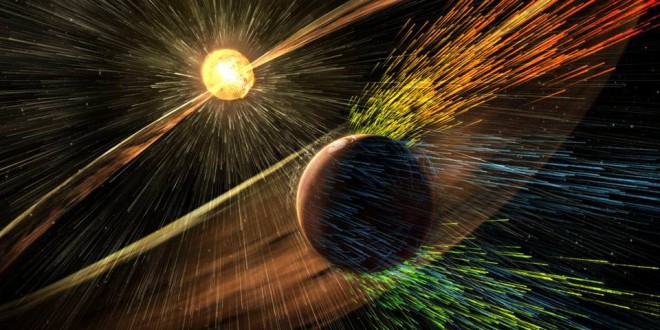Mars’ atmosphere is slowly leaking out into the cosmos, according to new data gathered from NASA’s MAVEN spacecraft. The cause of this great escape is our Sun; solar winds from the star constantly slam into Mars and strip away the atmosphere’s outer layers.
Measurements from Nasa’s Mars Atmosphere and Volatile Evolution (Maven) mission show that the atmosphere was ripped away by a huge burst of gas and magnetism from the Sun. The results of the mission bring far more detail to scientists’ understanding of how the Martian atmosphere changed during its early life.
When it was younger, Mars was much warmer and wetter — and so potentially far more hospitable to life. But at some point since, it has dried out and become far colder, making it harder to live there and leaving life very rare if it exists at all.
Instruments on board the Maven craft found that ions were escaping from the planet at a much quicker rate during solar bursts, or coronal mass ejections. Watching one such event in March, it saw huge magnetic rotations that were flying out thousands of miles into space — and that ions were spewing out into space along those huge magnetic ropes.
The ions that left the planet earlier in its life likely did so along the same route, getting flung out into the atmosphere and so making the planet the harsh landscape that it is today.
Another study looked at an aurora that could be seen on Mars’s northern hemisphere. It showed that aurora — which is akin to the Earth’s northern lights — dipped low into the Red Planet’s atmosphere.
Mars’s aurora is probably caused by the magnetic field in the crust, rather than the magnetism of the poles as it is in the Earth.
#MAVEN is on a mission to determine how #Mars lost its early atmosphere, and with it, its water. | https://t.co/wL0DxQ7N6m @NASAGoddard
— MAVEN Mission to Mars (@MAVEN2Mars) November 4, 2015
A third paper announced by Nasa supported the idea that magnetic fields related to the sun were changing the atmosphere on Mars. By analysing occasions when Maven dipped into the atmosphere of Mars and studied its makeup, it found that variations suggested magnetic fields were key to its changes — and that much of that magnetic field was being contributed by Mars’s surface.
Scientists said that the second study will allow scientists to explore the way that the solar wind and Mars’s atmosphere interact, and find what is keeping that atmosphere from escaping.
The fourth study released by Nasa explored the dust that was found in the Martian atmosphere. Scientists say that there is no process known that could whip dust up so high, and it is not coming from Mars’ moons — and so the dust is likely coming entirely away from the planet.
Agencies/Canadajournal
 Canada Journal – News of the World Articles and videos to bring you the biggest Canadian news stories from across the country every day
Canada Journal – News of the World Articles and videos to bring you the biggest Canadian news stories from across the country every day



